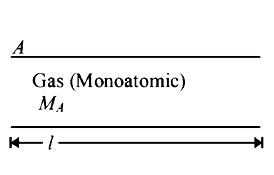Two narrow cylindrical pipes AandB have the same length. Pipe A is open at both ends and is filled with a monoatomic gas of molar mass MA. Pipe B is open at one end and closed at the other end, and is filled with a distomic gas of molar mass MB. Both gases are at the same tempreture.
(a) If the frequency of the second harmonic of the fundamental mode in pipe A is equal to the frequency of the third harmonic of the fundamental mode in pipe B, determine the value of MB/MB.
(b) Now the open end of pipe B is also closed (so that the pipe is closed at both ends). Find the ratio of the fundamental frequency in pipe A to that in pipe B.
The correct Answer is:A, B, C, D
(a) Second harmonic in pipe A is
2(v0)A=2[v2l]=1l√γARTMA
Third harmonic in pipe B is
3(v0)B=3[v4l]=34l√γARTMB
Given vA=vB
1l√γARTMA=34l√γARTMB
or, MAMB=γAγB×(43)2=5/37/5×169=400189


Now, (v0)A(v0)B=√γAγA×MBMB=34
Topper's Solved these Questions
Similar Questions
Two narrow cylindrical pipes AandB have the same length . Pipe A is open at both ends and is filled with a monoatomic gas of molar mass MA. Pipe B is open at one end and closed at the other end and is filled with a diatomic gas of molar mass MB. Both gases are at the same temperature .
a. If the frequency to the second harmonic of the fundamental mode in pipe A is equal to the frequency of the third harmonic of the fundamental mode in pipe B, determine the value of MA/MB.
b. Now the open end of pipe B is also closed ( so that pipe B is closed at both ends ). Find the ratio of the fundamental frequency in pipe A to that in pipe B.View SolutionWhat is the shortest length of a pipe open at one end and closed to other end resonates with the fundamental frequency n ?
View Solution
Knowledge Check
- Question 1 - Select One
A pipe open at both ends gives frequencies which are
Aonly even multiples of fundamental frequency.Bonly odd multiples of fundamental frequency.Call integral multiples of fundamental frequency.Dall fractional multiple of fundamental frequency. - Question 2 - Select One
The waves set up in pipes open at both the ends are
ALongitudinalBTransverseCLongitudinal stationaryDa and c - Question 3 - Select One
In an open organ pipe the fundamental frequency is 30 Hz.
If the organ pipe is closed at one end, then the fundamental frequency will beA10 HzB20 HzC30 HzD15 Hz
An organ pipe, open at both ends, contains
View SolutionThe fundamental frequency of a pipe closed at one end is 100Hz. If close end is open the fundamental frequency of same pipe wil be
View SolutionPipe A is 0.50 m long and open at both ends. Pipe B is open at one end and closed at the other end. Determine the length of pipe B so that it has the same fundamental frequency as A.
View SolutionThe frequency of the second overtone in a pipe open at both ends is n1. The frequency of the second overtone in a pipe of the same dimensions but closed at one end is n2. Then,
View SolutionIf the fundamental frequency of a pipe closed at one is 512HZ . The frequency of a pipe of the same dimension but open at both ends will be
View Solution

